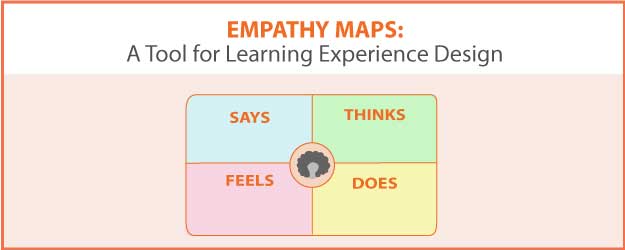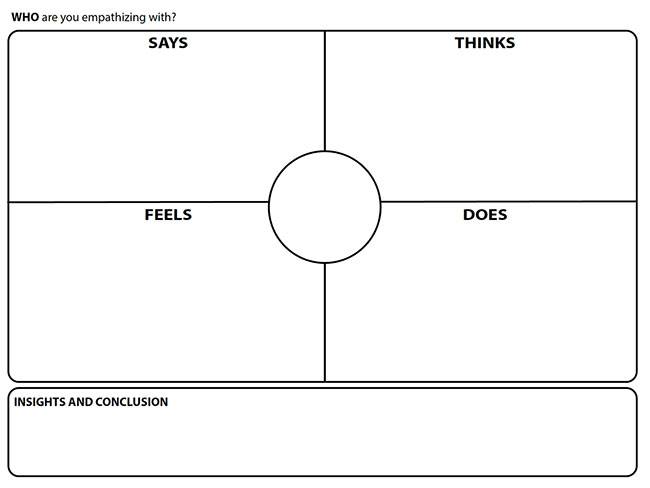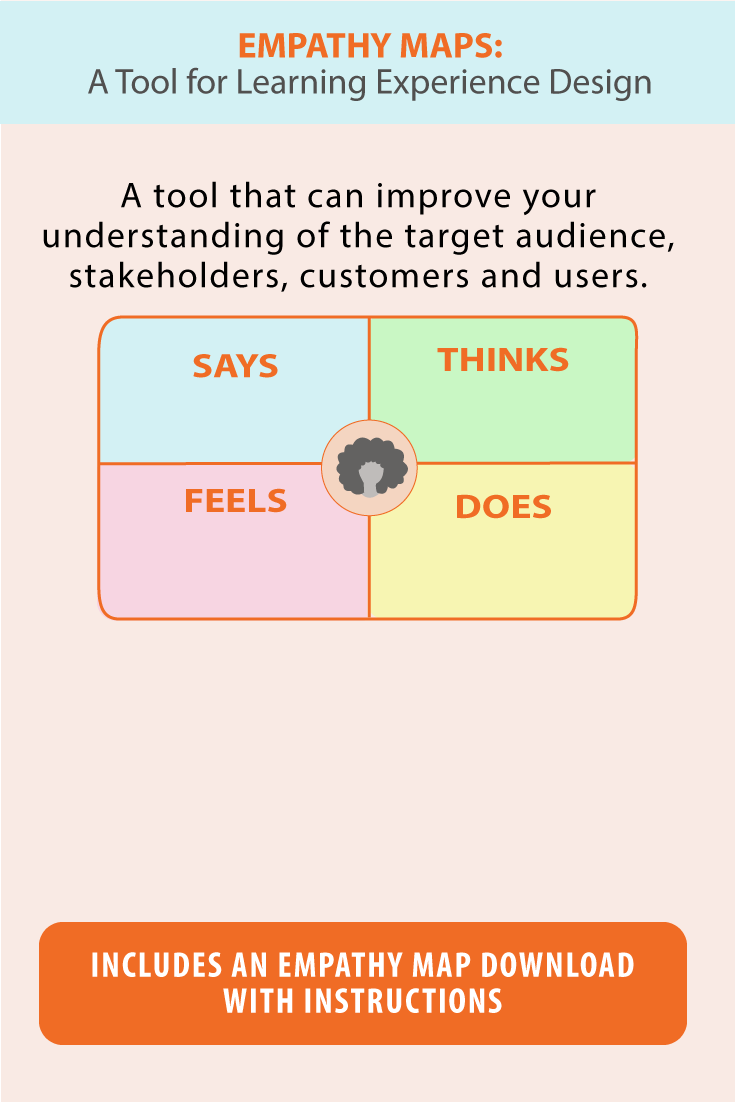
Learning experience design uses human-centered strategies and tools to develop empathy for a target audience or any group you are trying to understand. The empathy map, borrowed from user experience design, is an ideal tool for going deeper into the world of the people in your ecosystem. The concept comes from Dave Gray and his company XPLANE and is part of their human-centered design toolkit. This and other tools are explained in the book Gamestorming.
Goal of the Empathy Map
The empathy map captures and visualizes what a member of your target group might say, think, feel and do in relation to a question or event. The question can be about a situation at work, a learning experience, a process or any aspect of the target group for which you want greater insight. The goal is to improve your understanding and empathy of group members and to synthesize your observations, interviews and other research into a concrete and visual form. In terms of audience analysis, the empathy map complements the work you do to build personas.
Surprisingly, empathy maps can be helpful when you have little data to work with. They are a way to help you identify gaps in your understanding so you can fill in the holes.
Simple, Yet Deep
The simplicity of the empathy map belies the fact that it can reveal significant complexities about being human. For example, upon interviewing audience members, you may find inconsistencies in how people think, feel, speak and act. A person may think one thing, yet to protect their privacy, they say something else. Or a person may do one thing at work to adhere to a policy, but they may think it is not the best approach.
In learning experience design, when we empathize with users, participants and learners, we try to understand these types of complexities and how to best meet the needs of the audience.
Different Types of Empathy Maps
If you search for empathy maps, you will find several different forms. Remember that the purpose is to help you and your team develop empathy for an audience or other group. Here is a modified version of the original map, with the areas as rectangles rather than triangles for ease of writing.

In 2017 Dave Gray updated the map to improve it. The new model includes goals, a sequence for performing the process and Think and Feel are elevated to the focal point. Read more about the updated Empathy Map Canvas on Medium.
How to Use an Empathy Map
- Download the empathy map template with instructions below or make your own. They are simple to create by hand or in a graphic program.
- Just as with a persona, consider sketching a face in the center or inserting a graphic of a face. It helps to think in terms of a real person, even if it is a fictitious one.
- Identify a question, situation or event that you want to understand. Perhaps you want to understand what it’s like to be a new manager in an organization or to evaluate the effectiveness of a new hire orientation.
- Working with a team (or alone if you must), fill in the map using what you know about the persona. In the appropriate area of the map, add what individuals said, in response to your question. Then add what they though, did (actions they performed) and felt. At times, you may need to infer some of these. If you use sticky notes in each area, you can organize, modify and move them around.
- Discuss your findings and write your insights and conclusions on the page too. If you are working alone, see if you can find a partner to collaborate on the conclusions.
You can download an empathy map template with instructions by clicking the button below. You will also receive new articles, resources and great finds around once a month.
![]()


It’s crazy to not get access to the audience, but I know it happens. If you can do this, build a business case for why it’s important to give you access in terms of time, money, effort, and learning effectiveness.
Also, I think that’s perceptive of you to realize you could bias the data, so be mindful of that. Here’s what I recommend if you don’t have access. Find out as much as you can about the career(s) of the target audience. You can look at government statistics, job outlooks, and job postings (I often look at these for the tasks and responsibilities). If you know someone in a similar position that is not part of your target audience, see if you can chat with them. Search for articles and news about the challenges of the job role(s). If it’s just a matter of you not having permission but the audience is in your organization, I’d go under the radar and invite someone from the target audience for coffee… not an official interview or focus group. Don’t lose your job from any of my advice!
Hi Connie,
This is really useful and I’m just wondering what you recommend doing if you don’t have any access whatsoever to your audience do gather information. Do you have any tips? I see empathy mapping could work and personas, yet wouldn’t that all be my own biases without the real data?
Any pointers would be great.
Interesting comment and your ideas are sound. I recently heard a presentation by Hadiya Nuriddin. She commented that it’s not that people dislike change, but they dislike loss. It’s an interesting idea to explore. BTW, although I subscribe to the information processing theory, the idea of it being like a computer is outdated, I think. As you said, emotions, as well as our social relationships, our bodies and so many other dimensions of being human enter into it. So the theory may tell the story of cognitive processing, but there is much more going on.
Hi Connie Malamed
I am new to Instructional Design (ID) as well, a student. Thank you for your post. I have learned something new from this post and the post about personas which I know will help me as an ID, and in my current position as a classroom teacher to better understand the students. (The empathy map reminds me of the KWL (What you… Know, Want to…, and have Learned approach) which sort of does something similar except this approach is getting into the mind (knowledge) whereas the empathy map is both mind and emotions. Moreover, one cannot truly separate the two in understanding the learner and learning process. The mind and emotions affect learning and learning is affected by both.
However, as an ID and currently a classroom teacher, I can see how the empathy map can be of use to me in understanding the learner. I understand how the empathy map can give insight that informs how to effectively cater to learners and plan the learning process. As one gains understanding, without which our best strategies and approaches would likely fail, we become more effective in designing and executing.
Furthermore, you mentioned the complexities of the human in relation to using the empathy map and how there can be inconsistencies in the data to gain understanding. As I read your thought on it, I reflect on a previous course I did, which addressed changes in organizations and how to manage the change process. I learned that there are persons who are accepting of changes and buy in to the change effort and process but there are resistors to change efforts some of whom are passive, and others active. The passive resistor would be those people who say one thing but thinks and feels something else about the situation. In short, they may say that they are fine with the change but are not. Some active resistors may also fall into this category because they will verbalize their resistance to the change but what they feel or think is different from what they say, they will hide what they really think as you put it “to protect their privacy”. Sometimes what is in the private though is fear of the unknown which causes resistance.
ID, as a change agent, will have to understand the complexities of humans and know-how to interpret different feedbacks to make a fair or true conclusion. So, we cannot reply at face value because as the ID is learning about the group, they are engaged in the information processing according to the Information Processing Theory (IPT) computer metaphor in that we store, process, and retrieve information similarly a computer. But we differ in that we have emotions, which affects this process, and informs our discussions, along with the data. Therefore, passive resistors can be viewed by the ID as feedback or as potential problems, use and interpret the empathy map to effectively plan so that no one is left out because of what they think, feel, do, or say.
That’s a good point, Crystal. Yes, I think if done well the empathy map can work with anyone. You wouldn’t necessarily map it out in front of them. You would interview them, converse with them, try to get into their shoes. Then back at the office, listen to your recording or read your notes from the conversation and then fill out the empathy map. You might do these interviews with a partner to check whether you understood something correctly. So, the empathy map could be a composite of your interviews in the same way that a persona is. It complements and adds to the persona.
Hi Connie Malamed,
I am new to the field of Instructional design and I have been going through different blogs and sites that will help me learn about the world of instructional design as I am a current grad student at Walden University. Learning experience design caught my attention due to the fact that I could relate to just about everything you stated. When working with high school students they may be thinking one thing but say another due to not wanting to be wrong or state what they really are thinking. Putting our feelings onto paper such as this map is an easier method of getting students to reveal what they truly are thinking. Learning how your students learn and helping them build personas is deep in every level. As a future instructional designer I would like to use this empathy map and see what results I get. My question is does this map work on everyone including adults? As I have read about different strategies and skills of learning how to analyze and learn how your learners think and learn, it gets me thinking as I currently deal with adult teachers at the high school I work at; will this be effective the same way? I know that I as an adult still think one thing and say another outload. But I also think that adults know the concept of doing such an exercise they may still alter their answers.